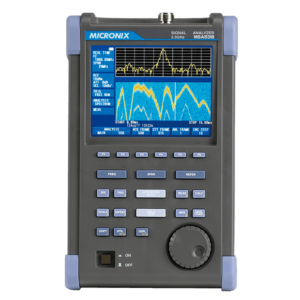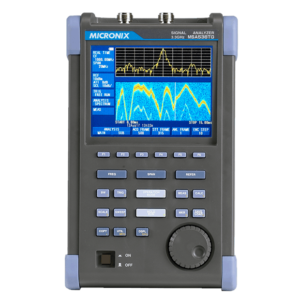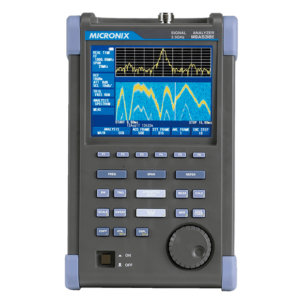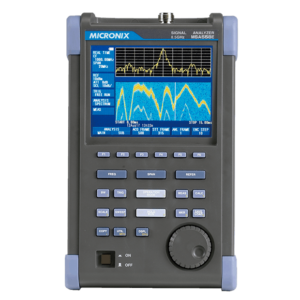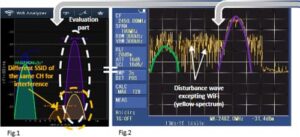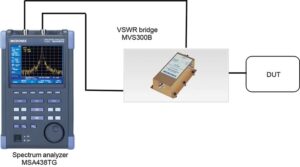What's real time system?
MSA500 series signal analyzer offers both the real time system based on Fast Fourier Transform(FFT) and the conventional sweep system.
Sweep system
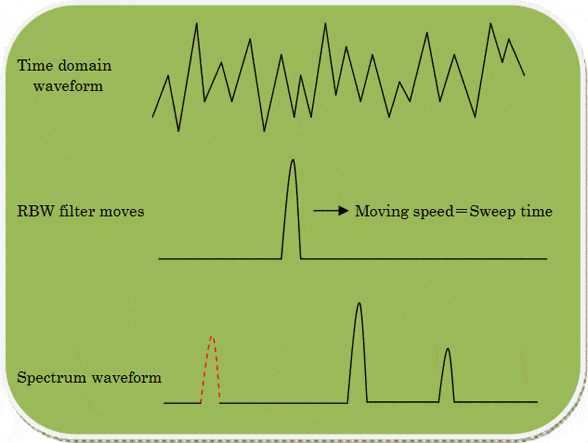
One RBW filter moves in the sweep range specified and then spectrum is displayed.
The speed at which the RBW filter moves is set by the sweep time.
If a spectrum doesn't exist the moment RBW filter comes to a position because the spectra change, that spectrum won't be observed like The red dotted line of the above figure.
Therefore, the sweep system basically treats a signal that spectrum does not change with This is called "steady signal". The signal which changes with time is called "unsteady signal". Typical example is the modulation signal.
Real time system
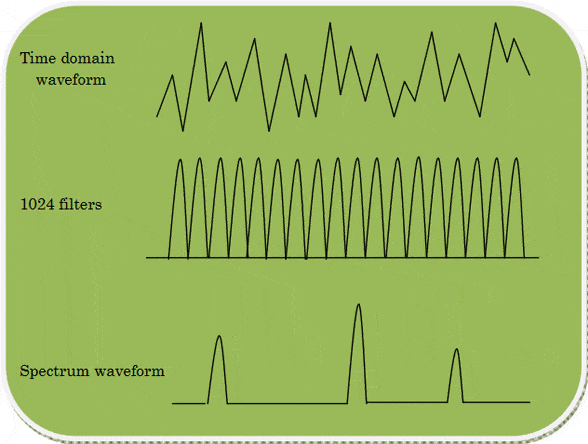
Many filters (1024 filters in MSA500) are arranged in parallel.
Therefore, the signal in a certain period is simultaneously transformed into spectrum.
This is a reason called real time.
Since the filters equal to the frequency resolution (Called FFT bin) are arranged in parallel, the signal in a certain period is processed at the same time. The spectra won't be missed at all even if those change with time. Any "unsteady signal" such as modulation signal can be treated.
About fast Fourier transform
In the real time system, time domain signal is converted into frequency domain signal using Fourier transform.
Time domain signal f(t) ⇒ Frequency domain singnal F(ω)
Conversion equation
$$ F(ω)\int_{-∞}^∞ f(t)ε^{-jωt}dt $$
$ω=2πf$ ($f$:frequency)
The fast Fourier transform FFT realizes faster calculation by devising calculation algorithm of the above equation.
Window function
The integration to ∞ from -∞ is necessary as shown in the above equation, but the signal captured during a certain period is actually processed.

The caluclation of Fourier transform is performed as the signal captured during T seconds is repeated.
Then, discontinuity points come out as shown in the above figure.
The spurious are generated by discontinuity point as shown in the figure below.
Called Side lobe.
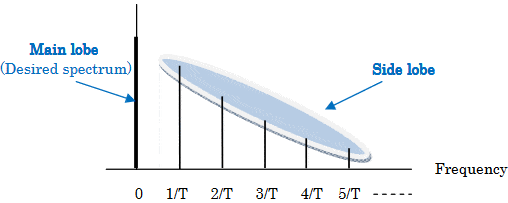
Of course, these side lobes are obstructive.
Window function is used to suppress these side lobes.
In order to eliminate the discontinuity, it is necessary that both first part and final part in the captured waveform are zero as shown in the figure below.

There are various kinds of window functions according to the purpose of use.
- Hanning
- Hamming
- Kaiser-Bessel
MSA500 has adopted 4-term Blackman-Harris window.
-
Features
- Excellent versatility
- About 95dB side lobe suppression
- Moderate width of main lobe as about two bins
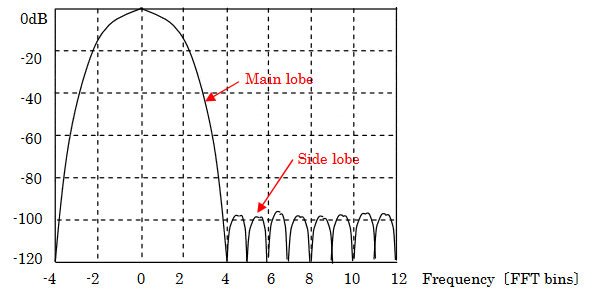
Shape of spectrum
In sweep system, the shape of a spectrum waveform is defined as shown in the following figure.
- RBW (Resolution bandwidth) ⇒ RBW from 300Hz to 3MHz can be set in sweep mode.
- Shape factor(Selectivity) ⇒ 3dB:60dB(RBW:BW60) In sweep mode, it doesn't depend on RBW but is 1:4.5.
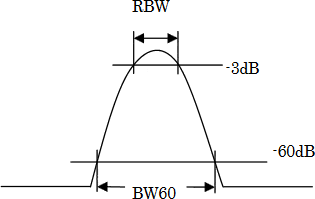
In real time system, the RBW setting is not performed.
As shown in the figure of 4-term Blackman-Harris window function on the previous page, the shape of spectrum is the same as shown in the figure below in every span.
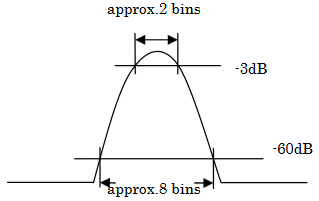
-
Actual waveform
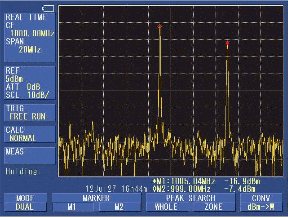
The bin expresses frequency resolution and every span consists from 602 bins (a part of 1024 bins by FFT operation).
- ∴3dB width =(2/602)x(span)
- And, shape factor=1:4(2bin:8bin)
As shown in the upper photograph, the shape is same on the screen in every span.
| Span | Δf(1bin) | 3dB width(2bin) |
|---|---|---|
| 20MHz | 33.22kHz | 66.2kHz |
| 10MHz | 16.61kHz | 33.2kHz |
| 5MHz | 8.31kHz | 16.6kHz |
| 2MHz | 3.32kHz | 6.6kHz |
| 1MHz | 1.66kHz | 3.3kHz |
| 500kHz | 831Hz | 1.66kHz |
| 200kHz | 332Hz | 662Hz |
| 100kHz | 166Hz | 332Hz |
| 50kHz | 83.1Hz | 166Hz |
| 20kHz | 33.2Hz | 66Hz |
Strong and weak points of real time system and sweep system
Real time system
- Strong points
- The spectrum analysis of unsteady signal such as burst signal and noise is available.
- The time domain analysis such as power vs. time, frequency vs. time, phase vs. time, IQ vs. time and Q vs. I is available.
- Since the trigger function is substantial, the spectrum which rarely occurs can be also captured certainly.
- Compared with OverWrite function in sweep mode, the spectra which are missed are much less. Especially, any spectrum isn't missed in the span narrower than 200kHz.
- How frequency and power of spectrum change over time can be observed in spectrogram analysis.
- Since the measured data is separated into I and Q d ata, modulation analysis of complicated signals such as phase modulation is possible.
- The frequency accuracy is very high as ±0.5ppm ±1dot at all points of screen.
- Weak point
- The maximum frequency span is as narrow as 20MHz.
Sweep system
- Strong points
- The wide frequency range can be observed ato a glance because the wide frequency span can be set.
- The tracking generator can be equipped.
- The EMI measurement conforming to the standard is possible.
- Since the sweep mode is a system of the conventional spectrum analyzer, users are familiar with it and applications are also abundant.
- Weak Points
- It is difficult to observe an unsteady signal, and even when it can be observed by using a MaxHold, it takes time to measure.
- The analysis in time domain is only at the zero span mode.
- The modulation analysis is impossible.
- The frequency accuracy on the screen is inferior compared to real time mode.
Maximum span 20MHz
Although the maximum span in sweep system is as wide as 3.3GHz@MSA538/538TG/538E or 8.5GHz@MSA558/558E, the maximum span in real time system is 20MHz. This is decided by 3RD IF frequency and the sampling rate of A/D converter.
However, in wireless communications system, especially modulation analysis, since allowable bandwidth is 20MHz or less in almost all systems, it will be acceptable.
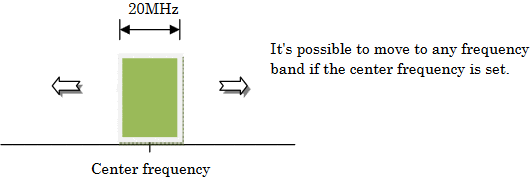
What's I and Q?
Refer to the whole block diagram. The figure below shows from 3RD IF to IQ conversion in it.
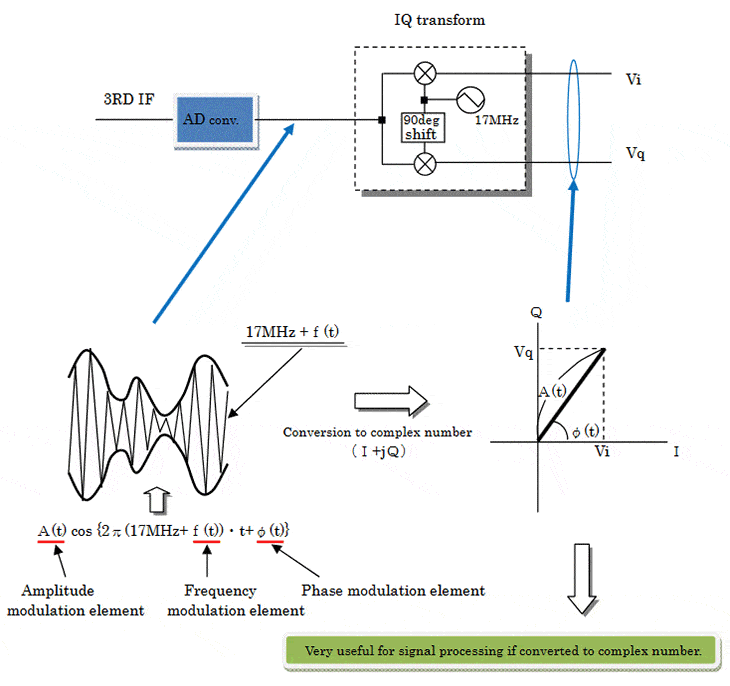
Advantage
- When the multiplication is executed in signal processing, the image won't be generated then.
- Multiplication with real number $(f_A x f_B)$ Result:$fA+fB$と$fA-fB$(image)
- Multiplication with complex number $(f_A x f_B)$ Result:$f_A+f_B$
- Time domain analysis can be performed by simple calculation as described.
«Power vs. time», «frequency vs. time», «Phase vs. time», «IQ vs. time», «Q vs. I» - If the input signal is a modulation wave, EVM or constellation can be calculated from I and Q data.
Bits of knowledge
- I In-phase
- Q Quadrature
Other favorite analyses
1. Time domain analysis
In real time mode, since 3RD IF which is analog signal is digitized by A/D converter and then is separated into I and Q, various time domain analyses are available.
Sampling frequencyfs=34MHz x (specified span/20MHz)

- Power vs. time
-
Power=(Vi2+Vq2)/50
The ASK signal, which is appeared in burst and whose amplitude is digitally modulated, can be observed.
-
ASK modulation wave of ETC
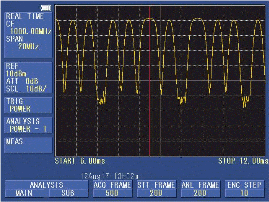
- frequency vs. time
-
frequency=(φn-φn-1)/360Ts
The signal wave modulated by frequency can be observed.
- φn:Current phase
- φn-1:Previous phase
- Ts:Sampling rate(1/fs)
-
FM modulation wave
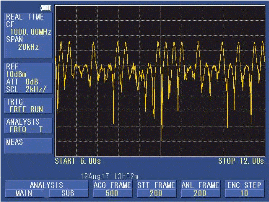
- Phase vs. time
-
Phase=tan-1(Vq/Vi)
It can be observed how the phase of the QPSK modulation wave changes over time.
-
Phase waveform of QPSK
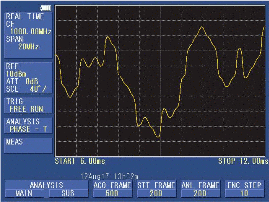
- I, Q vs. time
-
V axis:Vi and Vq, H axis:Time
The time domain waveforms of I and Q of phase modulation such as QPSK can be observed directly. Two waveforms of Vi and Vq are displayed.
-
I and Q waveform of QPSK modulation

- Q vs. I
-
V axis:Vq, H axis:Vi
The raw constellation waveform can be observed. It does not include initial phase compensation and frequency difference compensation of digital phase modulation.
-
BPSK constellation
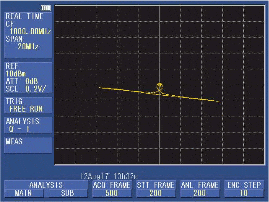
2. Spectrogram analysis
- The spectrogram displays the time response of frequency and power by X-Y axis and by X-Z axis respectively.
- Z axis is expressed by colors.
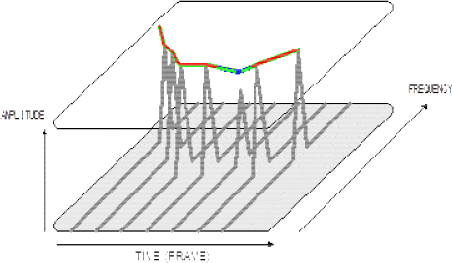
Application
-
Observation of frequency hopping of ZigBee
The time until frequency and power which instantaneously change get stable can be observed.
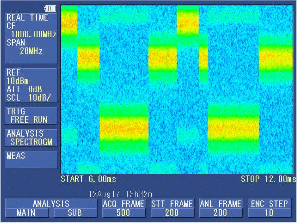
3. OverWrite analysis
-
OverWrite is a function in which the spectrum waveform of each frame is piled up and then displayed. The spectrum waveform is continuously accumulated at the rate of 720 frames/sec.
The occurrence frequency is expressed by colors.
«Difference from Overwrite in sweep system»
Accumulation rate is very slow in sweep system. For example, it is 5screen/s at 100ms sweep time.
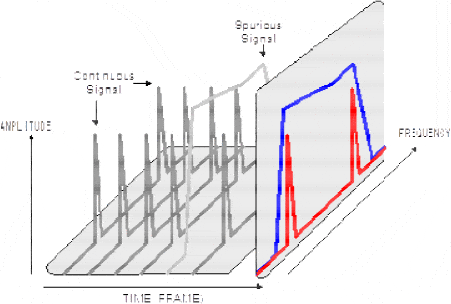
Application
-
Observation of unnecessary spectrum which appears rarely
The unnecessary spectrum (spurious) which disturbs a communication system may appear rarely. When span is wide, some spectra may be missed, but the probability of capturing spurious signal increases by setting the long accumulation time.
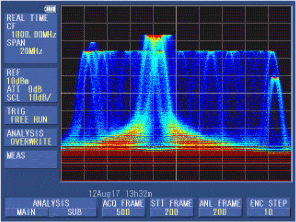
4. Modulation analysis
The modulation analysis can be accomplished by using the data separated to I and Q.
- 16K frame IQ memory:MSA500 series has the large IQ memory of 16K frames (64M bytes).
- USB interface:The data can be transferred as fast as 19ms/frame from IQ memory to PC through USB interface.
- PC:The transcerred IQ data are stored in PC.
- Modulation analysis software:Modulation analyses such as EVM measurement and constellation display
*It is necessary to design PC software at the user side.
Concept of trigger
In the sweep system, there is no concept of trigger basically. Because it handles the steady signal. In the real time system, however, FFT processing is performed to the signal captured on time domain. That is, the signal can be captured with trigger ev erywhere.
Optimum for measurement of such unsteady signal as modulation wave which occurs in burst.

The capturing range of a waveform is determined by Trigger, Pre-trigger and Span.
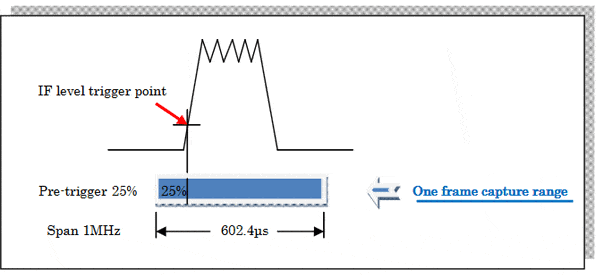
1. Trigger
- Channnel power trigger
- Power tigger
- IF level trigger
- External trigger
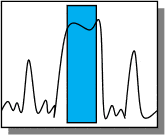 Span is equally divided into five channels (CH1 to CH5).
Span is equally divided into five channels (CH1 to CH5).
When the instantaneous value of whole power in the specified channel crosses the trigger preset value, the trigger signal is generated. The slope of "rising" or "falling" can be also set. It is conv enient when acquiring the burst signal.
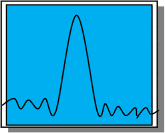 When the instantaneous value of whole power in the screen crosses the trigger preset value, the trigger signal is generated. The slope of "rising" or "falling" can be also set.
When the instantaneous value of whole power in the screen crosses the trigger preset value, the trigger signal is generated. The slope of "rising" or "falling" can be also set.
 When the level of IF signal (modulated with 17MHz) crosses the trigger preset value, the trigger signal is generated. The slope "rising" or “falling” is not available.
When the level of IF signal (modulated with 17MHz) crosses the trigger preset value, the trigger signal is generated. The slope "rising" or “falling” is not available.
The trigger signal is generated by the signal input to EXT TRIG connector. The input voltage range is from 1 to 10 Vp-p, and the frequency range is from DC to 5MHz. The slope of "rising" or "falling" can be a lso set.
2.Pre-trigger
By setting Pre-trigger, the signal before a trigger point is analyzable. When Pre-trigger is set to 0%, the signal after trigger point is captured. When being set to 50%, each 50% of signal after and before trigger point is captured. When being set to 100%, the signal before trigger point is captured. Five positions can be set 0% to 100% in 25% step.
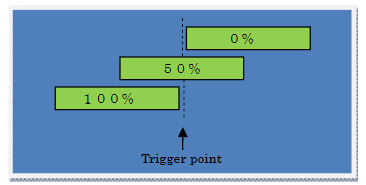
3.Span
The frame time depends on span and is decided by it.
| Span | Sampling rate | Frame time |
|---|---|---|
| 20MHz | 34MHz | 30.12μs |
| 10MHz | 17MHz | 60.24μs |
| 5MHz | 8.5MHz | 120.5μs |
| 2MHz | 3.4MHz | 301.2μs |
| 1MHz | 1.7MHz | 602.4μs |
| 500kHz | 850kHz | 1.205ms |
| 200kHz | 340kHz | 3.012ms |
| 100kHz | 170kHz | 6.024ms |
| 50kHz | 85kHz | 12.05ms |
| 20kHz | 34kHz | 30.12ms |
Products introduction
Handheld signal analyzer MSA500 series
With Fast Fourier Transform (FFT) and conventional sweep systems, each strong point of both systems is usable.

Please feel free to contact us.
If you want to verify 5G, customize a radio wave shield box, or need product repair, please do not hesitate to contact us about any small matter.

